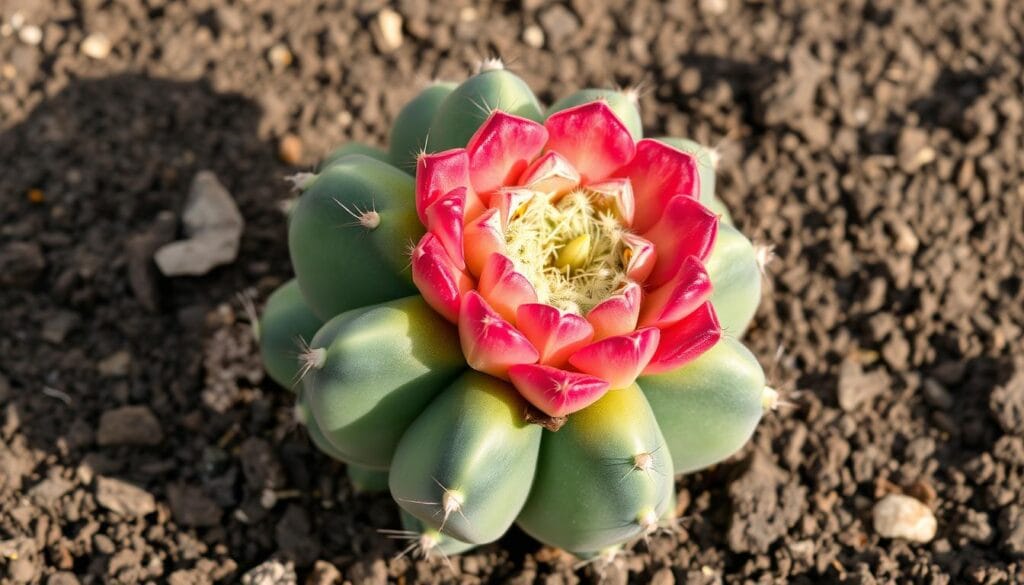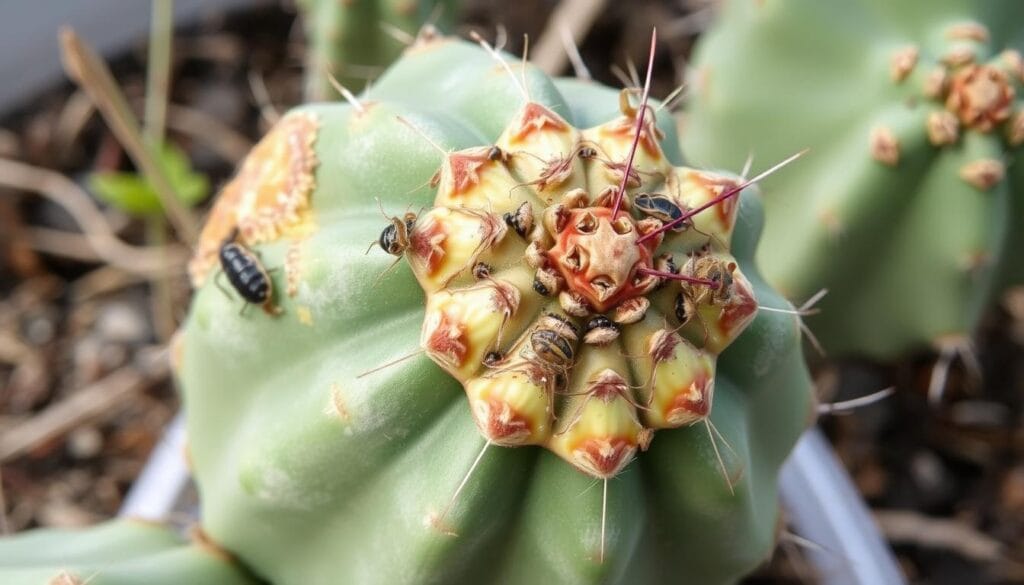Did you know the Moon Cactus, a colorful gem, lives only about a year1? It’s a vibrant succulent from South America, part of the Cactaceae family, known as Gymnocalycium mihanovichii1. Despite its short life, it’s loved for its beauty and easy care.
I’ve loved these colorful succulents since 20172. They’re unique, with a colorful top grafted onto a green base. The Purple Moon Cactus, a Gymnocalycium mihanovichii friedrichii variety, is often seen on top of other cacti, making a beautiful sight2.
Moon Cacti do best in bright, indirect light with some direct sun1. They like hot temperatures and need water when it’s dry, making them great for indoors2. They can grow up to 12 inches tall, but they’re easy to care for1.
Key Takeaways
- Moon Cactus has a short lifespan of about one year
- It’s a grafted cactus combining two different species
- Native to South America and belongs to the Cactaceae family
- Prefers bright indirect light with some direct sun
- Requires low water and maintenance
- Can grow up to 12 inches tall
- Thrives in hot temperatures with regular watering during dry conditions
Introduction to Moon Cactus: A Colorful Marvel
I’m excited to introduce you to the moon cactus, a stunning member of the gymnocalycium genus. These moon shaped cacti are a sight to behold, boasting vibrant hues that make them stand out in any collection.
Origin and Unique Characteristics
Moon cacti hail from the arid regions of South America, where they’ve adapted to harsh conditions with minimal water. What sets them apart is their lack of chlorophyll, contributing to their eye-catching range of colors3. You’ll find these grafted cacti sporting tops in shades of orange, red, yellow, or pink.
The Grafting Process: Two Plants in One
Moon cacti are actually two plants in one! The colorful top is grafted onto a green base cactus, allowing it to survive despite its chlorophyll deficiency. This fusion creates captivating colorful cactus varieties that thrive indoors4.
Lifespan and Growth Expectations
While often considered short-lived, moon cacti can surprise us. With proper care, these resilient plants can bring joy for several years3. Their growth is limited due to their grafted nature, but they make up for it with their unique beauty. To prolong their lifespan, I recommend placing them near bright light sources and maintaining stable temperatures4.
Interestingly, moon cacti play a role in biodiversity. Their nectar-rich flowers attract pollinators like bees and butterflies, aiding in cross-pollination3. This makes them not just a pretty face, but an important part of our ecosystem.
Understanding Moon Cactus (Gymnocalycium mihanovichii)
I’m excited to explore the world of moon cactus species. The Gymnocalycium mihanovichii, also known as the moon cactus, is a colorful marvel. It grows to about 4 inches tall and 5 inches wide5.
The moon cactus is known for its vibrant colors. While it’s naturally green, it can turn different colors due to mutations. This includes the ‘Hibotan’ cultivar, which lacks chlorophyll and shows various pigments6. Because of this, it needs a special way to grow.
Moon cacti are created by grafting Gymnocalycium mihanovichii onto a Hylocereus cactus5. This grafting is key for the plant’s survival and its unique look. It’s interesting to know that about 15 million grafted cacti are traded worldwide, with moon cactus being the most common5.
For gymnocalycium mihanovichii care, these plants love warm, dry places. They do best in temperatures between 60°F to 80°F (15°C to 27°C) and need bright, indirect light indoors57. In the wild, they grow up to 500 meters in Paraguay and northeast Argentina6.
| Characteristic | Description |
|---|---|
| Size | 2-4 inches tall, 3-5 inches wide |
| Light Requirement | 14-16 hours of natural/artificial light |
| Watering Frequency | When top inch of soil is dry |
| Temperature Range | 60°F to 80°F (15°C to 27°C) |
| Propagation Methods | Cutting, offset, grafting |
Moon cacti are loved for their striking looks, but they don’t live long. They usually die in a couple of years, but with good care, they can last up to five years5. Knowing these special traits is crucial for their care.
Ideal Growing Conditions for Moon Cactus
To grow a moon cactus indoors, you need to pay attention to a few key things. These plants are special because they have unique needs. They are different from other cacti.
Temperature Requirements
Moon cacti love warm temperatures. They grow best between 15° – 32°C (59° – 90°F)8. It’s important to keep them away from cold air and never let them get too cold, below 12°C (54°F)8. If you’re growing them outside, they can handle temperatures as low as 30°F (zone 10 in the US)9.
Humidity Preferences
Moon cacti don’t like humid places. They come from dry areas in South America, like Argentina, Bolivia, Brazil, and Paraguay9. To keep them happy, make sure they have good air flow.
Light Needs: Balancing Top and Bottom
Lighting for moon cacti is tricky because of their special grafting. The top part needs shade, but the bottom needs more light. I find the best spot is bright, indirect light with a bit of morning sun8. This setup is like their natural home, where they grow under taller plants10.
Don’t forget, moon cactus owners often make mistakes with too much water and not enough light8. By giving them the right warmth, low humidity, and light, you’ll create a perfect home for them to flourish9.
Soil and Potting Requirements
Moon cacti do well in a rich, fast-draining cactus potting mix with a low pH11. It’s important to use a well-draining soil to avoid root rot12. The best pH for moon cactus soil is between 5.5 and 7.5, helping them get the nutrients they need12.

For potting, pick a small container with holes for drainage. Moon cacti like small spaces and don’t need to be repotted often. They only need a new pot every 3 to 4 years11. To help with drainage, put a layer of gravel at the pot’s bottom.
You can choose between commercial cactus mixes or make your own. Store-bought mixes are easy, but making your own can save money and let you tailor the mix12. Here’s a simple DIY succulent soil recipe:
| Ingredient | Proportion | Purpose |
|---|---|---|
| Potting soil | 2 parts | Base medium |
| Coarse sand | 1 part | Improve drainage |
| Perlite | 1 part | Enhance aeration |
Proper soil and potting are key for healthy moon cacti. By giving them the right environment, your moon cactus will thrive for many years.
Watering Your Moon Cactus
Watering your moon cactus right is key to its health. I’ll show you how to water it properly, including a schedule and how to avoid too much water.
Frequency and Amount
Moon cacti need specific watering. In hot months, I water mine once a week13. In cold months, I don’t water at all14. It’s important to let the soil dry out completely before watering again.
Seasonal Adjustments
I change how often I water based on the season. In cooler months, I only water when the soil is very dry13. This helps them thrive, just like in their desert home.
Signs of Overwatering and Underwatering
Too much water is a big problem. I look for yellow leaves and mushy roots as signs of too much water13. Too little water shows as wilted or dry leaves and soil pulling away from the pot13.
“Cacti prefer a drought to a flood.”
This saying helps me remember to water less. It’s better to let a cactus dry out than to cause root rot.
| Watering Aspect | Summer | Winter |
|---|---|---|
| Frequency | Once a week | Only when bone dry |
| Amount | Moderate | Minimal |
| Soil Condition | Allow to dry between waterings | Keep mostly dry |
Using well-draining soil with perlite or sand is crucial to avoid root rot13. By following these tips, you’ll learn to care for your moon cactus and enjoy its beauty for many years.
Fertilization and Nutrient Needs
Moon cacti need special nutrients that are different from most plants. They grow well in poor soil, just like their native South America15. Since they grow slowly, they don’t need to be fertilized often to stay colorful.
When it’s time to feed your moon cactus, a little goes a long way. Use cactus fertilizer made for succulents16. I suggest a light application of this fertilizer in the spring. It helps them bloom without harming the plant.
Don’t overdo it with the fertilizer. Too much can hurt the roots and make the plant sick. Instead, focus on giving it the right environment. These plants are tough and can handle low nutrient levels.
For the best care, repot your moon cactus every year or when it gets bigger15. This refreshes the soil and gives it a bit of extra nutrition. By doing this, your moon cactus will stay healthy and colorful for about a year1615.
Pruning and Maintenance
Keeping your moon cactus happy is easy. I’ll show you the key care steps to make sure it thrives.
Removing Offsets
Moon cacti don’t grow much but might produce small offsets or “pups” at the base17. When this happens, gently remove these offsets for succulent pruning. Use a clean, sharp knife to separate the pups from the mother plant. This keeps your cactus healthy and looking good.
Dealing with Discoloration
If your moon cactus has beige patches, it’s sunburned17. These plants like bright, indirect light with only 1-2 hours of slanted sunlight daily171. Move it to a spot less than one foot from a window for the best light15.
Cleaning and Pest Prevention
Regular cleaning is key for pest control for cacti. Use a soft brush to gently remove dust from the cactus surface. For newly propagated moon cacti, apply neem oil spray to prevent pests17. Watch out for pests like mealybugs or spider mites.
| Maintenance Task | Frequency | Notes |
|---|---|---|
| Watering | Every 2 weeks | Less in winter, avoid overwatering1715 |
| Pruning | As needed | Remove offsets when they appear |
| Cleaning | Monthly | Dust removal with soft brush |
| Fertilizing | Once a year | Apply succulent fertilizer in spring1 |
Remember, moon cacti usually last six months to a year17. Don’t worry if it doesn’t last long. With the right care and attention, you can enjoy your colorful cactus for as long as possible.
Common Pests and Diseases
As a moon cactus lover, I’ve seen many pests and diseases. These plants face threats from tiny enemies. Spider mites, almost invisible, can be deadly if not treated18. Scale insects also pose a big risk, potentially killing the plant if not treated18.
Mealybugs are another problem. They look like white, cottony clumps and can cause sooty mold, stunted growth, or even death18. In damp conditions, fungus gnats and fruit flies lay eggs in the soil, damaging roots18.

Moon cactus issues often come from wrong care. Too much water can turn leaves and soft, a sign of root rot19. Not enough water causes leaves to wilt, turn brown, and grow slowly19. It’s important to water less in cooler months19.
Identifying and Treating Issues
Look for yellow speckles, spider mite webs, or white fuzzy growth to catch pests and diseases early19. For pests, neem oil or insecticidal soap work well. Fungicides might be needed for fungal issues19. Here’s a quick guide to common moon cactus problems:
| Problem | Signs | Treatment |
|---|---|---|
| Spider Mites | Tiny webbing, discoloration | Repeated insecticidal treatments |
| Mealybugs | White, cottony masses | Alcohol swabs, horticultural oils |
| Root Rot | Mushy, discolored roots | Remove rotted parts, repot in fresh soil |
| Stem Rot | Soft or brown, water-soaked stem | Remove affected areas, adjust care routine |
Prevention is key. Proper care, like right watering and good air, can avoid many problems19. By being careful and quick to act, you can keep your moon cactus happy and healthy.
Propagation Techniques for Moon Cactus
Propagating moon cacti is an exciting journey. These plants are special because they are grafted. Let’s look at some good ways to grow them.
Grafting New Tops
Grafting is a key method for moon cactus growth. If the base gets old, I can attach a new top. This needs skill and is best for those with experience. I keep the temperature between 60-75°F (15-24°C) for best growth.
After two weeks, I look for signs that the new top is growing. This means the grafting was successful20.
Rooting Offsets
Rooting offsets is a faster way to grow new plants compared to seeds21. These offsets won’t have the colorful top but can grow into new plants. I water them carefully to avoid rot and watch their growth closely20.
If the offsets don’t grow, I check if I’ve watered too much. I also look at the health of the parent plant20.
It’s important to sterilize when growing moon cacti to avoid diseases21. I use a soil mix with 80% inorganic stuff like pumice or perlite to keep moisture away21. After planting, I slowly introduce them to outdoor conditions to prevent shock. Growing moon cacti is a long-term effort but very rewarding for my indoor garden21.
FAQ
What is a Moon Cactus?
How big does a Moon Cactus grow?
What is the ideal temperature for a Moon Cactus?
How much light does a Moon Cactus need?
How often should I water my Moon Cactus?
Does a Moon Cactus need fertilizer?
How do I propagate a Moon Cactus?
What are common pests and diseases for Moon Cacti?
Source Links
- How to Plant, Grow and Care For Moon Cactus Plants
- Care Diary – Gymnocalycium mihanovichii and friends – Trex Plants
- Cafe Planta
- Grafted Cactus Lifespan – Comprehensive Guide & FAQs
- Controversial, Colorful Moon Cactus | The Succulent Eclectic
- Gymnocalycium mihanovichii
- Cafe Planta
- All You Need to Know about Growing Moon Cacti !(Ruby Ball Cacti)
- Caring for Moon Cactus, also called Grafted Cactus or Hibotan
- Moon Cactus Info: Learn About The Care Of Moon Cactus
- How to Care and Grow Moon Cactus (Ruby Ball Cactus)
- 🌵 Best Potting Soil Mix For Moon Cactus
- 🎈 What Is The Best Way To Water a Moon Cactus?
- How to Take Care of Moon Cactus | Plantly
- Moon Cactus Plant Care: Water, Light, Nutrients | Greg App 🌱
- Magical ‘Moon Cactus’: Gymnocalycium Mihanovichii And 4 Things To Know About It
- This Funky Cactus Has A Short Lifespan—But You’ll Still Want One In Every Color
- What Are The Bugs on My Moon Cactus? 🐞
- How Can You Tell If A Moon Cactus Is Dying?
- Propagating Variegated Moon Cactus: The Ultimate Guide
- 🎈 Propagating Moon Cactus: Step-by-step Guide


